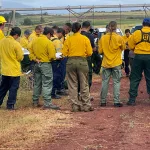After spending hours in the classroom learning how to conduct backburns for fire control or prescribed burns for pre-fire suppression, two dozen federal, state, and county firefighters recently completed ignition training. The training will provide another tool in the box for Hawai‘i wildland firefighters who anticipate more frequent and more ferocious fires.
During the day, experts from the U.S. Forest Service wrapped up ignition training by conducting a field exercise on former agriculture lands in south Kaua‘i where hundreds of acres here are covered in invasive grasses, the most common fuel for wildfire in Hawai‘i. Some 25% of the land across the state is covered by these grasses, adding to the overall potential for devastating wildfires.
Prescribed fires are commonly started across the western U.S. mainland and the military conducts these pre-planned fires often in Hawai‘i to reduce fuel loads and thus, the threat of uncontrolled fires.
After an extensive briefing, firefighters split into three teams to practice setting up and lighting drip torches. These canisters contain a mixture of diesel fuel and gasoline and once lit, are used to light grasses or other vegetation.
For the exercise, three sections of grass-covered land were surrounded on all sides by firebreaks (graded dirt roads) to prevent flames from jumping from one spot to another.
On training day, with rain overnight, high humidity, and wet grasses, the trainers were not sure they could get anything started. While the green grass in the sectioned-off areas was tough to ignite and did not burn fully, the experience was enough to give firefighters the practical knowledge they need to start backburns or prescribed burns.
In order to use prescribed burning as a fire prevention tool, fire agencies have to get a permit from the Department of Health Clean Air Branch. Agencies need to produce a formal burn plan and be familiar with the area to be burned, the fuel types, and weather conditions.
Photo credit: DLNR
